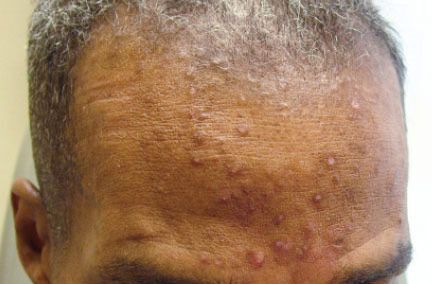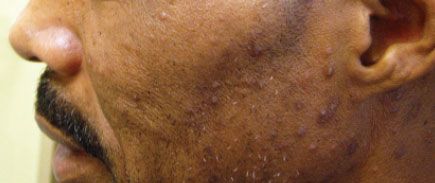Eosinophilic Pustular Folliculitis in an HIV-Positive Man
This HIV-positive, 48-year-old man presented with new-onset acne-like, pruritic lesions on his face. These erythematous painful papules had developed 2 months before presentation. The patient was taking antiretrovirals and trimethoprim/sulfamethoxazole for the HIV infection.
This HIV-positive, 48-year-old man presented with new-onset acne-like, pruritic lesions on his face. These erythematous painful papules had developed 2 months before presentation. The patient was taking antiretrovirals and trimethoprim/sulfamethoxazole for the HIV infection.
A biopsy specimen was obtained from the patient’s forehead; the differential diagnosis included eosinophilic pustular folliculitis (EPF) and granulomatous rosacea. His absolute CD4+ cell count was 67/µL, well below the threshold of 250/µL usually seen in patients with EPF.1 The hemoglobin level was 9.8 g/dL. All other laboratory test results were normal.
The biopsy specimen showed abundant eosinophils and superficial granulomatous infiltrate. The diagnoses of sarcoidosis and granulomatous rosacea were entertained, but neither disease presents with eosinophilia. Eosinophilic invasion of the pilar root sheath and sebaceous glands was not present as would be expected with EPF. However, this finding is usually identified after serial specimens are examined with careful analysis of every hair follicle.2

The patient was given doxycycline, 100 mg bid, and desonide cream (applied twice daily to decrease inflammation).3 Other therapies were considered, but none are uniformly effective. There was modest clearing of the lesions after a few months of treatment with topical corticosteroids.
EPF is extremely difficult to diagnose; the diagnosis frequently becomes clear after HIV infection has been diagnosed. Some believe that EPF is caused by an immune-mediated hypersensitivity to the fungus Malassezia.4 Multiple bacteria have also been blamed, but treatment with antistaphylococcal antibiotics has not been effective.3 Prednisone can be used at an initial dose of 70 mg PO, tapered over 2 weeks; however, lesions frequently reoccur once the medication is stopped. Phototherapy with UV radiation has produced a clinical response in a few cases. Dapsone therapy remains to be fully explored and tested. In the presence of underlying immunodeficiency, EPF usually does not respond to any treatment and the lesions reoccur when the treatment is stopped.

Dermatological conditions are often a presenting clue to HIV infection in immunosuppressed patients. One such condition is EPF, a part of the immune restoration syndrome. This unique culture-negative HIV-related disorder often manifests itself when CD4+ cell counts drop below 250/µL.5,6 Most patients with EPF are men in their 30s and 40s,7 who complain of a chronic, edematous, follicular eruption involving the trunk and face.6
The incidence of HIV/AIDS continues to be on the rise throughout the world. HIV-related dermatosis is being seen at all levels of care, and its unique presentation and treatment should be explored.
References:
REFERENCES:
1.
Rosenthal D, LeBoit, Klumpp L, Berger TG. Human immunodeficiency virus-associated eosinophilic folliculitis. A unique dermatosis associated with advanced human immunodeficiency virus infection.
Arch Dermatol.
1991;127:206-209.
2.
Piantanida EW, Turiansky GW, Kenner JR, et al. HIV-associated eosinophilic folliculitis: diagnosis by transverse histologic sections.
J Am Acad Dermatol.
1998;38:124-126.
3.
Fearfield LA, Rowe A, Francis N, et al. Itchy folliculitis and human immunodeficiency virus infection: clinicopathological and immunological features, pathogenesis and treatment.
Br J Dermatol.
1999;141:3-11.
4.
McCalmont TH, Altemus D, Maurer T, Berger TG. Eosinophilic folliculitis. The histologic spectrum.
Am J Dermatopathol.
1995;17:439-446.
5.
Ofuji S, Ogino A, Horio T, et al. Eosinophilic pustular folliculitis.
Acta Derm Venereol.
1970;50:195-203.
6.
Ofuji S. Eosinophilic pustular folliculitis.
Dermatologica.
1987;174:53-56.
7.
Ellis E, Scheinfeld N. Eosinophilic pustular folliculitis: a comprehensive review of treatment options.
Am J Clin Dermatol.
2004;5:189-197.